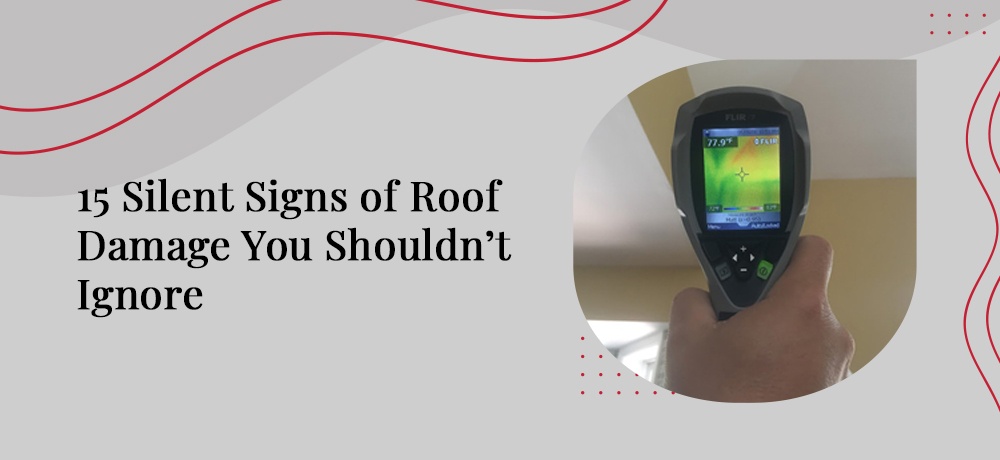15 Silent Signs of Roof Damage You Shouldn’t Ignore

As a homeowner, it’s crucial to keep an eye on the condition of your roof to prevent potential problems that can lead to extensive damage and costly repairs. In this blog post, we will explore 15 silent signs of roof damage that often go unnoticed but shouldn’t be ignored. By being aware of these signs, you can take timely action and ensure the longevity and safety of your home.
1. Damaged Plumbing Vent Boots
Plumbing vent boots play a vital role in preventing water from entering your home along the pipes. Cracks, broken seams, or rotted rubber boots can allow water to seep into your house. It’s essential to inspect these boots regularly and replace them if necessary.
2. Ceiling Stains
Water stains on your ceilings or running down your walls are often a clear indication of a leaky roof. Even if the issue seems minor, it’s important to address it promptly to prevent more significant problems like mold growth and structural damage.
3. Shiners
In cold attics, you may find “shiners,” which are nails that missed the framing and become frosted with condensation. These nails can cause leaks over time and should be clipped using side-cutting pliers.
4. Damaged Shingles
Broken or missing shingles not only compromise the appearance of your roof but also create potential entry points for water. If you can find matching shingles and are comfortable working at heights, replacing them is a straightforward repair.
5. Dirty, Clogged Soffits
Proper attic ventilation is essential to maintain the health of your home. Clear soffits allow air to flow, preventing moisture buildup and mold growth on your roof’s framing. Regularly inspect and clean your soffits to ensure optimal ventilation.
6. Mold Where Roof and Exterior Wall Meet
Lack of kick-out flashing at the edge of a roof where it meets a sidewall can lead to water intrusion, rot, and even structural damage over time. Installing kick-out flashing is crucial to divert water away from the wall and prevent long-term issues.
7. Rusted Gutters
Leaking gutters often start at rusty spots or seams that have opened due to expansion and contraction. Use roof and gutter repair tape to cover the damaged areas temporarily and address the rust to prevent further deterioration.
8. Roof Vent Issues
Cracked housings on plastic roof vents or broken seams on metal ones can lead to water infiltration. Caulking is not a long-term solution; replacing damaged vents is necessary. Ensure proper installation using rubber-washered screws and caulk for added water protection.
9. Loose Step Flashing
Step flashing is critical where the roof intersects with walls. If the flashing rusts or comes loose, water can enter the house. Understanding how to install step flashing correctly can help you address this issue effectively.
10. Mold on Exterior Walls
Mold growth on exterior walls might indicate a roof leak. Inspect the area and check for ground sloping toward the house or downspouts emptying next to the wall, which can contribute to water infiltration.
11. Holes Drilled on Purpose
Tiny holes in shingles, whether from past satellite dish or antenna mounting brackets, can cause hidden damage over time. Fill these holes with appropriate flashing techniques rather than just applying caulk.
12. Missing Gutter Apron
The absence of a gutter apron can cause water to wick behind the gutter, leading to rot in the fascia, soffits, and roof sheathing. Look for water stains below the gutter, indicating that the gutter apron is missing and should be installed.
13. Rusted Chimney Flashing
Flashing around chimneys can rust, allowing water to enter the house. Replacing old flashing with new material can redirect water away from the chimney and prevent further damage.
14. Stains Around a Bathroom Fan
Water stains around your bathroom fan’s ceiling might indicate a leak from the vent cap on the roof. However, condensation is a more common cause. Properly insulate the bath fan ducting to prevent condensation-related issues.
15. Hail Damage
Hailstorms can cause damage to your roof, such as tearing or puncturing shingles, and dislodging protective granules. It’s essential to inspect your roof after a hailstorm and address any visible damage to prevent long-term deterioration.
Identifying these silent signs of roof damage and taking prompt action can save you from significant headaches and expenses down the line. Regular roof inspections, maintenance, and timely repairs are key to ensuring the longevity and integrity of your home.
Note: The information provided in this blog post is based on an article titled ’15 Silent Signs You Have a Damaged Roof’.
If you’re looking for a leading asbestos inspection, air quality testing, and environmental consulting in Yorktown Heights, NY, reach out to GEO Environmental Co., Inc. We have over thirty years of experience in environmental testing and consulting, and our state-certified specialists provide various types of services while helping you comply with the myriad of regulatory requirements.
Get in touch with us today!
To learn more about the services we offer, please click here. To get in touch with us, please click here or give us a call at
(914) 962-1086.